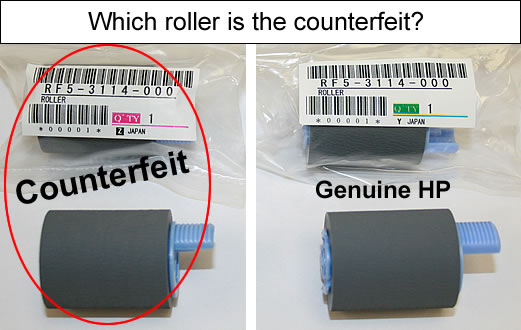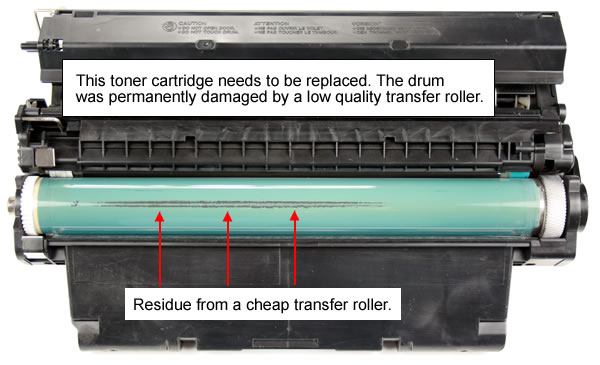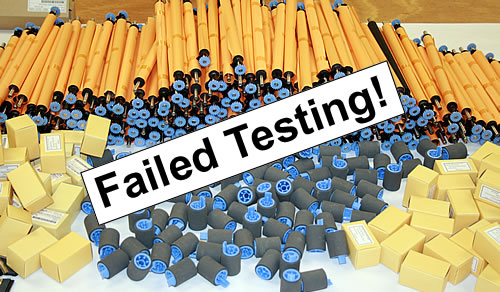Parts: the Good, the Bad, and the Ugly.

The roller on the left is the counterfeit. Hard to tell the difference isn't it? It even fooled us at first. After all, the packaging looks the same, and the rollers look the same. But we found a problem when we tested the roller in a printer; it started slipping, causing a paper jam. We thought, "This is strange—a defective HP roller?" We tried a few more and half couldn’t consistently feed paper. That’s when we looked very closely and noticed the rubber had a slightly different texture and feel. The rubber compound was too cheap and caused the roller to slip on the paper.
So what happened? We ordered a bulk quantity of what were supposed to be genuine HP rollers from a distributor that stocked both genuine HP rollers and this aftermarket look-alike roller, but the supplier's warehouse personnel couldn’t tell the difference. So the aftermarket rollers got dumped in the bin with the genuine HP rollers. We were able to exchange the counterfeit rollers for genuine HP rollers and the distributor supposedly straightened the problem out on their end.
What really annoys me about this is the fact that there is a factory or factories out there pumping out tons of shoddy counterfeit parts with the intent to deceive people into thinking they are buying genuine HP parts. I mean these are printer rollers, nothing sexy and glamorous like fake Rolex watches. But if a foreign factory sees an opportunity to make money with counterfeit parts, they’ll make them. Then depending on the ethics of the sales people the parts might be sold as genuine HP parts, OEM parts, “Chinese OEM”, “Japanese OEM”, clones, etc. At this point the parts enter US distribution channels, often under the guise of being genuine HP parts.
Definitions:
- OEM – stands for Original Equipment Manufacturer.
- OEM parts – This term is thrown around loosely, so we prefer to use the term Genuine HP parts if we are talking about HP parts. These are genuine replacement parts made by the OEM. In most cases they are the highest quality parts available.
- Aftermarket parts – sometimes called 3rd party parts, are made by anyone other than the OEM. Quality varies from abysmally poor to excellent. In some cases OEM parts may not be available and aftermarket parts are the only option.
- New parts – there are several classifications of new: new OEM parts, new aftermarket parts, and equivalent to new (ETN). (Ever wonder why prices vary so much?!)
- Equivalent to new (ETN) – This one reeks of something fishy. These parts are usually advertised as new and often at steeply discounted prices. Some may be returns or pulls out of new printers, but most are factory refurbished. Factory refurbished means they are refurbished by the OEM or a subcontractor for the OEM. This is just a slippery play of words; a refurbished product shouldn’t be sold as new. That’s why you can’t always make an "apples-to-apples" comparison with parts suppliers. Companies sometimes play fast and loose with the marketing lingo, and what is said to be new might not be new.
- Compatible – This term is usually used with remanufactured or new-aftermarket toner cartridges and fusers. Because most are remanufactured, they are environmentally friendly and considerably less expensive than OEM products. Compatibles can be a great deal but like anything else, you often get what you pay for. The cheapest compatibles usually have the highest defect rates, lowest print quality, and shortest longevity. Again, it helps to develop a relationship with a vendor you can trust.
Finding the good parts
It's important to note that not all aftermarket parts are junk, some are excellent, and they can certainly save you money. For some older printers like the LaserJet 4, 4Plus, and 5, genuine HP parts are no longer made so aftermarket parts are your only choice. The challenge is in finding a company committed to testing to make sure parts really work, instead of simply selling the cheapest junk available. We have that commitment, and we have tested aftermarket parts from many overseas factories. Believe me, quality varies greatly.
Testing is especially important with aftermarket transfer rollers. For example, on one older LaserJet model we did a considerable amount of testing before we could find a reliable transfer roller that worked when duplexing (double sided printing). Most transfer rollers failed the duplex test, including a transfer roller sold by one of the largest North American parts distributors. (Just because a company is big, doesn’t mean it is better!)
In the worst case, we have tested transfer rollers that physically damage the drum in a toner cartridge. As you can see below, the transfer roller left a residue on the cartridge drum that could not be wiped away. This toner cartridge is ruined.

Regardless of where the parts come from, aftermarket or OEM, does the company you buy parts from have the ability and commitment to testing parts they sell? Or are they just repeating what the factory or distributor is promising about quality? At PrinterTechs, we're not just a warehouse full of parts or an online reseller! We have knowledgeable technicians and a hands-on commitment to quality.





